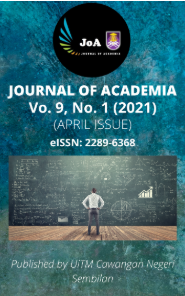ANTIOXIDANT ACTIVITY, TOTAL PHENOLIC AND FLAVONOID CONTENT FROM LEAVES AND SEED EXTRACTS OF
Keywords:
Hevea brasiliensis, extraction yield, antioxidant, phenolic, flavonoid contentAbstract
Rubber tree or Hevea brasiliensis is an industrial crop from Euphorbiaceae family that grows in tropical climates and commonly known as an important economical commodity to Malaysia. However, there is a little information available on its phytochemicals in each part of rubber tree as well as their antioxidant activity. The aims of this study are to determine the extraction yield of different clone of rubber tree as well as to determine the antioxidant activity, total phenolic and flavonoid content from leaves and seeds extracts. The leaves and seeds extraction process were optimized by varying different parameter’s such as drying temperature, types of solvent used and temperature of extraction. The drying process was done at temperature of 70℃ for 24 hours. The dried samples were macerated with methanol and the extract was concentrated using rotary evaporator at 60℃. The highest percentage of inhibition was based on the weight of dried plant materials. The determination of antioxidant was assessed by using the DPPH assay method. The total phenolic and flavonoid content was determined by using Folin-Ciocalteau assay and aluminium chloride colorimetric assay respectively. From this study, the result indicates that, the highest extraction yield was seeds extract (29.77%) from clone RRIM 2020. The highest amount of antioxidant was (79.16) from clone RRIM 2025. Therefore, the highest amount for total phenolic and flavonoid content were clone RRIM 2020 (0.020) and RRIM 3001 (0.200) respectively. As a conclusion, it showed that each clone gives a different result on each of the analysis. The result will be benefit to others for their reference in order to produce the product.
References
Abu Bakar, M. F., Mohamed, M., Rahmat, A., & Fry, J. (2009). Phytochemicals and antioxidant activity of different parts of bambangan (Mangifera pajang) and tarap (Artocarpus odoratissimus). Food Chemistry 113(2): 479-483.
Altemimi, A., Lakhssassi, N., Baharlouei, A., Watson, D., & Lightfoot, D. (2017). Phytochemicals: Extraction, Isolation, and Identification of Bioactive Compounds from Plant Extracts. Plants, 6(4), 42. https://doi.org/10.3390/plants6040042
Apak, R., Güçlü, K., Demirata, B., Özyürek, M., Çelik, S. E., Bektaşoğlu, B., Berker, K. I., & Özyurt, D. (2007). Comparative evaluation of various total antioxidant capacity assays applied to phenolic compounds with the CUPRAC assay. Molecules, 12(7), 1496-1547. https://doi.org/10.3390/12071496
Bag, G. C., & Devi, P. G. (2015). Research Article Assessment of Total Flavonoid Content and Antioxidant Activity of Methanolic Rhizome Extract of Three Hedychium Species of Manipur Valley 1. International Journal of Pharmaceutical Sciences Review and Research, 30(28), 154–159.
Baysan, U., Çoşkun, N. Ö., Elmas, F., & Koç, M. (2020). Frequently Used Membrane Processing Techniques for Food Manufacturing Industries. Applications of Membrane Technology for Food Processing Industries, 45.
Blainski, A., Lopes, G. C., & de Mello, J. C. P. (2013). Application and analysis of the Folin Ciocalteu method for the determination of the total phenolic content from Limonium brasiliense L. Molecules, 18, 6852-6865.
Brand-Williams, W., Cuvelier, M. E., & Berset, C. (1995). Use of a free radical method to evaluate antioxidant activity. LWT - Food Science and Technology, 28(1), 25–30. https://doi.org/10.1016/S0023-6438(95)80008-5
Gupta, V. K., & Sharma, S. K. (2006). Plants as natural antioxidants. Natural Product Radiance, 5(4), 326-334.
Ismail, M., Bagalkotkar, G., Iqbal, S., & Adamu, H. A. (2012). Anticancer properties and phenolic contents of sequentially prepared extracts from different parts of selected medicinal plants indigenous to Malaysia. Molecules 17(5): 5745-5756.
Kiranmai, M., Kumar, C. M., & Mohammed, I. (2011). Comparison of total flavanoid content of Azadirachta indica root bark extracts prepared by different methods of extraction. Research Journal of Pharmaceutical, Biological and Chemical Sciences, 2(3), 254-261.
Kondratyuk TP, Pezzuto JM. (2004). Natural Product Polyphenols of Relevance to Human Health. Pharm Biol; 42:46-63.
Pandey, K., & Rizv, S. (2009). Plant polyphenols as dietary antioxidants in human health and disease. Oxidative Medicine and Cellular Longevity, 2(5), 270–278.
Pramai, P., Abdul Hamid, N. A., Mediani, A., Maulidiani, M., Abas, F., & Jiamyangyuen, S. (2018). Metabolite profiling, antioxidant, and α-glucosidase inhibitory activities of germinated rice: nuclear-magnetic-resonance-based metabolomics study. Journal of Food and Drug Analysis, 26(1), 47–57. https://doi.org/10.1016/j.jfda.2016.11.023
Rizk, A. M. (1987). The chemical constituents and economic plants of the Euphorbiaceae. Botanical Journal of the Linnean Society, 94(1–2), 293–326. https://doi.org/10.1111/j.1095-8339.1987.tb01052.x
Selmar, D. and Kleinwächter, M. (2013). Influencing the product quality by deliberately applying drought stress during the cultivation of medicinal plants. Industrial Crops and Products 42: 558-566.
Sembiring, E. N., Elya, B., & Sauriasari, R. (2017). Phytochemical Screening, Total Flavonoid and Total Phenolic Content and Antioxidant Activity of Different Parts of Caesalpinia bonduc (L.) Roxb. Pharmacognosy Journal, 10(1), 123–127. https://doi.org/10.5530/pj.2018.1.22
Sreelatha, S., Jaacob, J., Prakash, G., Simon, S. P., Annamalainathan, K., & Chandrasekahn, T. R. (2003). Antioxidant defence systems and drought tolerance in Hevea brasiliensis. Indian Journal of Natural Rubber Research, 16(1 & 2), 93-101.
Swain, T., & Hillis, W. E. (1959). The phenolic constituents of Prunus domestica. I. The quantitative analysis of phenolic constituents. Journal of the Science of Food and Agriculture, 10(1), 63–68. https://doi.org/10.1002/jsfa.2740100110
Vessal, M., Hemmati, M., & Vasei, M. (2003). Antidiabetic effects of Quercetin in streptozotocin-induced diabetic rats. Comparative Biochemistry and Physiology Part C: Toxicology & Pharmacology, 135(3), 357-364.
Verheye, W. (2010). Growth and production of rubber. In Land use, land cover and soil sciences. UNESCO-EOLSS Publishers.
Downloads
Published
Issue
Section
License
Copyright (c) 2021 Journal of Academia

This work is licensed under a Creative Commons Attribution-NonCommercial-NoDerivatives 4.0 International License.












